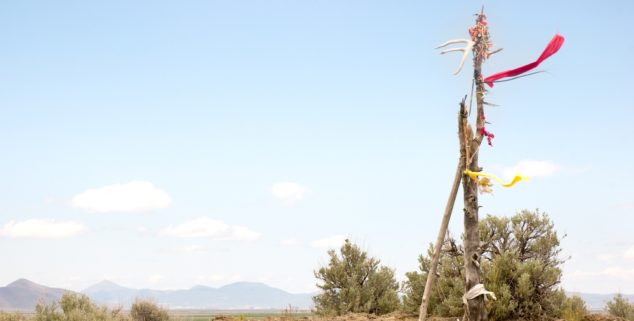News
Siskiyou-area tribe’s reinstatement questioned
 A Native American flag totem in rural Siskiyou County. (Photo: Zack Frank, via Shutterstock)
A Native American flag totem in rural Siskiyou County. (Photo: Zack Frank, via Shutterstock)A move to restore federal tribal recognition to a long defunct Siskiyou County Indian rancheria has received a major blow.
Research done by a college professor indicates no Indian ever lived on the 441-acre Ruffey Rancheria outside Etna. Stephen Dow Beckham, a history professor at Lewis & Clark College in Oregon and an expert in American Indian history, said there is no evidence that any group of people considered themselves part of a Ruffey Rancheria tribe or set up a tribal government or had a relationship with the federal government.
“This is an attempt to resurrect a tribe where there was no tribe,” said Josh Saxon, executive director of the Karuk Tribe, which hired the professor to investigate the tribe’s legitimacy.
Congress terminated the rancheria along with 40 others a part of the California Indian Rancheria Act of 1958
Tahj Gomes, a Chico attorney who is chairman of Ruffey Rancheria, did not respond to a request for comment. But he was quoted in the Eureka Times-Standard as saying Beckham’s report is factually wrong and that he overlooked a list of tribe members who were residents “on or near the original reservation lands or on other lands purchased or leased for the Ruffey Rancheria members” and correspondence between the rancheria and the Bureau of Indian Affairs.
Congressman Doug LaMalfa, R-Richvale, who is sponsoring House Resolution 3535, to restore the tribe’s recognition, also contests the report. Parker Williams, his communications director, said Beckham’s claims are “inaccurate and disingenuous.” He said the report “has no impact on the Congressman’s ongoing efforts to right a historic wrong done to Ruffey Rancheria.”
Congress terminated the rancheria along with 40 others a part of the California Indian Rancheria Act of 1958. LaMalfa testified before Congress that Ruffey Rancheria is one of the last few remaining terminated California Indian rancherias that have not yet been restored to federally recognized status. He testified that the rancheria tribal members “have deep roots in Siskiyou County that can be dated back generations.”
But Beckham said to date neither Gomes nor LaMalfa have provided him with any documents to backup their claims.
“I’ve never seen anything like it,” he said, explaining that he has never seen so little public documentation associated with a tribe seeking federal recognition.
“No Indian ever lived on the property,” he said. “That leaves the question: ‘What is there to restore?”
The story of Ruffey Rancheria dates back to 1905 when Congress authorized an Indian agent to buy land for poor Indians.
Beckham said it is troubling that Gomes is the only person who has been publicly revealed as a member of the tribe. Gomes has declined to release tribal council members or the names of any other tribe members. In addition, Gomes has previously presented himself publicly as the Chairman of the also unrecognized Etna Band of Shasta Indians. Many of his family members are Karuk Indians.
Beckham questioned who Gomes’ financial backers are and what their motivations are.
He says the issue is significant because if Ruffey Rancheria receives federal tribal recognition it would allow them to establish a reservation anywhere in Siskiyou County and get water rights. The group would be on par with the Navajo Nation and the Sioux and could have the right to build a casino.
The story of Ruffey Rancheria dates back to 1905 when Congress authorized an Indian agent to buy land for poor Indians. The agent bought Ruffey Rancheria in 1907 for two Karuk families, thinking that it was the home of “Old Man Ruffey,” the rancheria’s namesake. But it turned out the land wasn’t suitable because of poor soil, lack of water and steep hills.
At the time of the California Indian Rancheria Termination Act, the Bureau of Indian Affairs distributed the rancheria land to Old Man Ruffey’s three grandchildren. They in turn quickly sold it off to the International Paper Company.
“It’s a brushy, forested hillside,” Beckham said. “No one lives there today.”
“We believe there are some legitimate restoration bills in Congress right now. This isn’t one of them.” — Josh Saxon
Gomes was quoted in the Eureka newspaper as saying Beckham is a “hired gun who is willing to draw whatever conclusion best suits his current employer.”
Beckham said he has no personal stake in the question of federal recognition and merely looked at the evidence in the records in the National Archives in San Bruno relating to Ruffey Rancheria. “There is no fault in my being paid for my time as a research historian to have carried out that task and write the report.”
Saxon, the executive director of the Karuk Tribe, said his tribe would normally not get involved in another tribe’s quest for federal recognition. “We believe there are some legitimate restoration bills in Congress right now. This isn’t one of them. This is so far from a restoration bill that we have to say something.”
LaMalfa’s bill narrowly passed out of the House Natural Resources Committee in May on a 19-18 vote and now goes to the House Rules Committee.
Want to see more stories like this? Sign up for The Roundup, the free daily newsletter about California politics from the editors of Capitol Weekly. Stay up to date on the news you need to know.
Sign up below, then look for a confirmation email in your inbox.

Convenient opinion considering it was paid for. Read contradicting article regarding Dr Beckham’s ever-changing opinion. This is dispute between two tribes in Siskiyou county.
Beckham is a “Hired gun who is willing to draw whatever conclusion best suits his current employer”. Nuff said.
As if we dont get enough fake blood quantum claims from Palestine https://uploads.disquscdn.com/images/a75420cf190ccb5316de565419927b45c3677a26be9c4770efd0171f2897502d.jpg